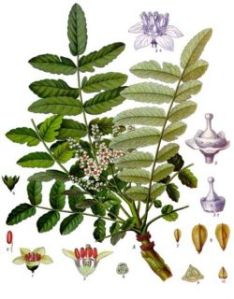
The Chopra Centre. (2014). Boswellia. Retrieved from: http://www.chopra.com/community/online-library/ayurvedic-herbs-foods/boswellia
Botanical Name: Boswellia serrata
Common name: Boswellia, Indian Frankincence, Sallaki (Sanskrit), Salai guggal (Hindi) (Bone & Mills, 2013, p. 441)
Family: Burseraceae (Bone & Mills, 2013, p. 442)
Parts used: Resin (Bone & Mills, 2013, p. 442)
Quality: Bitter, pungent, astringent and sweet (Pole, 2006, p. 179). The herb is considered heating for its blood circulating properties and cooling due to its anti-inflammatory action (Pole, 2006, p. 179).
History/Folklore: Boswellia serrata from the genus Boswillia and is comprised of a range of small shrubs and trees native to North Africa and Asia. The many speices exude fragrant resins known as frankincense or oleo-gum. Boswellia serrata is related to B. carterii or “biblical frankincense”, and has a long history of therapeutic use notably in Auyrvedic medicine (Bone & Mills, 2013, p. 441).
The herb has a long-term connection with the spiritual realm and religious ceremony, and is also used for psychiatric conditions (Pole, 2006, p. 179). It is seen to have a specific effect on ājñā cakra (the spiritual centre, which is connected to the pituitary and hypothalamus (Pole, 2006, p. 179).
Constituents: penacyclic triterpene acids (mainly β-boswellic acid and acetyl-boswellic acids); tetracyclic triterpene acids; essential oil; terpenols; monosaccharides; uronic acids; sterols aand phlobaphenes (Bone & Mills, 2013, p. 442)
Actions
- Anti-inflammatory (Bone & Mills, 2013, pp. 441, 442)
- Anti-allergic (Bone & Mills, 2013, p. 443)
- Anti-cancer (Bone & Mills, 2013, p. 443)
- Analgesic (Pole, 2006, p. 179)
- Anti-rheumatic (Bone & Mills, 2013, p. 441; Pole, 2006, p. 179)
- Emmenagogue (Pole, 2006, p. 179)
- Antispasmodic (Pole, 2006, p. 179)
The herb has being studied in the treatment of Alzheimer’s and other inflammatory brain conditions due to its ability to cross the blood brain barrier (Bone & Mills, 2013, p. 441).
Ayurveda specific: Destroys toxins, reduces kapha and vāta, rejuvenating, useful in gynecology, rediracts vāta flow downwards, clearns adhesions from the body (Pole, 2006, p. 179).
Indications
- Asthma (Bone & Mills, 2013, pp. 441, 446)
- Inflammatory bowel disease (IBD) (Bone & Mills, 2013, p. 441)
- Ulcerative colitis (Bone & Mills, 2013, p. 446)
- Crohn’s Disease (Bone & Mills, 2013, p. 446)
- Rheumatoid arthritis (Bone & Mills, 2013, p. 441)
- Osteoarthritis (Bone & Mills, 2013, pp. 441, 444-446)
- Oedema in correlation with brain tumor (Bone & Mills, 2013, p. 441)
Dosage & Preparation:
- Resin decoction: 3-9g/day (Pole, 2006, p. 180)
- Tincture (1:5 in 90%): 2-10mL/day
Cautions & Contraindications
- Pregnancy (Pole, 2006, p. 180)
- Weakened digestion (Pole, 2006, p. 180)
Combinations
- For inflammation and arthritic conditions: combine with guggulu, myrrh and tumeric (Pole, 2006, p. 180)
- For male sexual debility: combine with gokshura, ashwagandha and bala (Pole, 2006, p. 180)
Interactions: Moderate to potent inhibitors of applied CYP enzymes (Bone & Mills, 2013, p. 447)